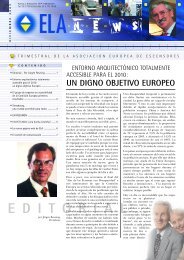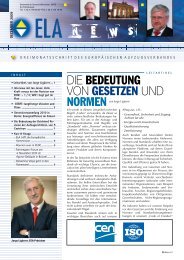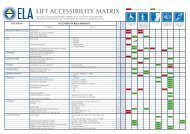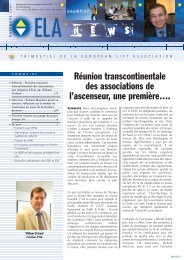WP6-Brochure-E4 brochure - ELA European Lift Association.
WP6-Brochure-E4 brochure - ELA European Lift Association.
WP6-Brochure-E4 brochure - ELA European Lift Association.
You also want an ePaper? Increase the reach of your titles
YUMPU automatically turns print PDFs into web optimized ePapers that Google loves.
17 Avoid stalled motor door operator<br />
Arbitrarily opening doors are a safety hazard in lifts. Therefore, car doors have to remain shut<br />
while the car is moving, for safety reasons. Some locking mechanisms rely on a stalled motor to<br />
keep doors closed, also when the car is not in use [13]. Therefore, these systems require<br />
energy permanently.<br />
Recommendation: using door‐locking mechanisms that do not permanently require energy for<br />
the locking mechanism when the lift is not in use.<br />
Relevance: this is both relevant for new installations and (smaller) retrofits.<br />
18 Use energy‐efficient transformer and power supply<br />
Some lift circuits require low voltage energy that is supplied by a transformer or power supply.<br />
Recommendation: the efficiency of this transformer or power supply during operation should<br />
be selected as high as possible, while stand‐by consumption should be low (cp. [12], p. 34).<br />
Relevance: this is both relevant for new installations and (smaller) retrofits.<br />
19 Use energy‐efficient components for all other components and equipment<br />
An installation includes further equipment, such as ventilation systems, operating panels,<br />
buttons, intercoms, etc. that are not discussed in detail in this document. However, it may be<br />
worthwhile to check the energy efficiency of these components as well.<br />
Recommendation: for ventilation, high‐efficiency motors should be used. Operating panels,<br />
buttons and other auxiliary equipment should also be selected to be as energy‐efficient as<br />
possible.<br />
Relevance: this is both relevant for new installations and retrofits.<br />
When energy‐efficient equipment is selected, the equipment has to be properly installed to<br />
make use of its full energy‐saving potential. Table 7‐7 discusses the role of installation quality<br />
and the lift‐building interface.<br />
Table 7‐7. Energy efficiency: <strong>Lift</strong> installation<br />
20 Ensure installation quality<br />
Installation<br />
A factor influencing the energy consumption of a lift is the quality of the installation. A bad<br />
installation quality often has a negative impact on energy consumption. If guiding rails are for<br />
example poorly installed, additional friction is induced, thus more energy is needed to move<br />
the car.<br />
Recommendation: the installation of a system should be accomplished by personnel with the<br />
appropriate qualifications. Otherwise, energy losses are likely to occur due to bad installation<br />
quality, sometimes even negating the effects of the selected energy‐efficient equipment.<br />
Relevance: all lift installations.<br />
111

















